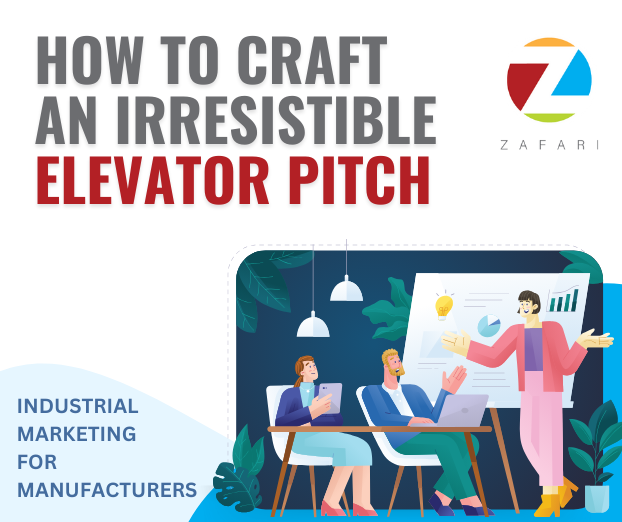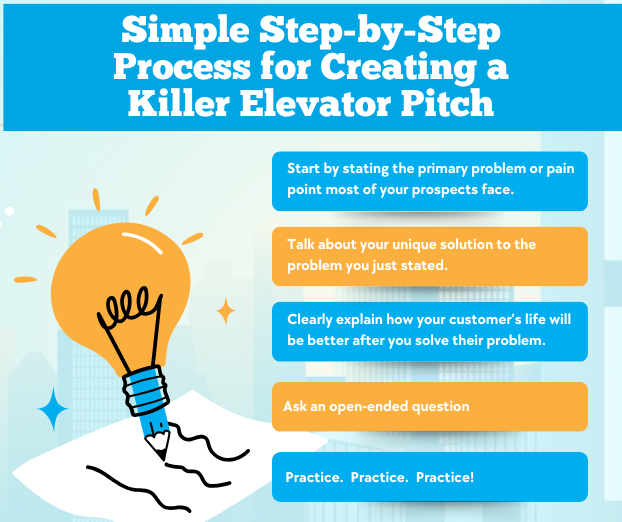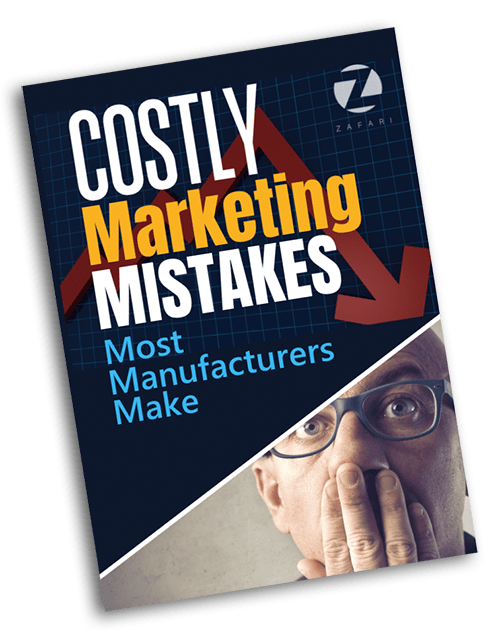Everyone has heard of an “elevator pitch” – a 30-second ‘commercial’ that business and sales people use in networking meetings and, perhaps, elevator rides.
But how many elevator pitches are really engaging and compelling? Have you ever gone to a networking lunch or mixer and watch someone’s eyes glaze over as soon as you start pitching yours? Have you done the same to them? That’s because most elevator pitches are created from the perspective of the company, not the end customer.
You rattle off a boring rote blurb you’ve said a thousand times such as ‘I’m a [job title] at Acme Manufacturing. We make precision laser-cut widgets’. After the first few words, the person has already zoned out at best or has even started eyeing the banquet table or exit door. Unfortunately, they’ve completely lost interest.

The Importance of an Effective Elevator Pitch for B2B Industrial Manufacturers
Being a B2B manufacturer, an effective elevator pitch can make a big impact in grabbing attention, sparking interest, and ultimately securing partnerships, investments, or sales.
And it’s not just for the sales team. A well-crafted pitch can serve as your social media profile, get highlighted on your home page and even help boost morale by giving your team clarity about how their job makes a difference in the world.
The importance of having an effective elevator pitch multiplies in this technology-driven age where our attention spans have become incredibly short.
On average, people can only pay attention for about 8 seconds before getting distracted. And that number keeps going down!
With such limited attention spans, it’s crucial to capture the interest of your audience right away. Lengthy presentations just won’t cut it anymore, unless your audience is already seriously considering a purchase. That’s where crafting the perfect elevator pitch comes in. You need to hook your prospects quickly and leave them eager for more.
A great pitch doesn’t waste time. It gets straight to the point in a compelling way. Those first few seconds determine whether your prospect will engage further or tune out.
Simple Step-by-Step Process for Creating a Killer Elevator Pitch
It’s critical that your pitch is clear and direct. It should be no longer than 15 or 30 seconds long when spoken or read.
With that little time to make an impactful impression, you’ve got to get right to the point. In a way that matters to the listener or reader.

To do that, we recommend using the power of storytelling. Here’s how you do it:
1 – Start by stating the primary problem or pain point most of your prospects face.
2 – Talk about your unique solution to the problem you just stated.
3 – Clearly explain how your customer’s life will be better after you solve their problem.
Here’s an example for Acme, a fictitious manufacturer of water connectors:
1 – Many water connector suppliers can be hard to work with.
2 – At Acme, our easy, online ordering process ensures customers can always get what they need when they need it.
3 – When you have a reliable partner you can trust, you can enjoy peace of mind and focus on what matters most – growing your business.
Next, you put it all together:
Many water connector suppliers can be hard to work with. At Acme, our easy, online ordering process ensures customers can always get what they need when they need it. When you have a reliable partner you can trust, you can enjoy peace of mind and focus on what matters most – growing your business.
By formulating your pitch in this way, you open by stating the prospects primary pain point. This grabs their attention right away, if they are in that segment. Next you point out how you solve the problem and what life will look like as a result. If the person on the other end is in your target audience, you better believe they will want to hear more!
After the Pitch, Ask An Open-Ended Question:
After you share what is your business and how it can help, it is important to get your potential customers involved.
Ask open-ended questions that encourage conversation. Be ready to answer any questions they have for you.
For example, after the Acme elevator pitch we formulated above, you can ask—
“What’s your biggest frustration getting water connectors?”
Practice Makes Perfect:
How you communicate matters as much as what you say. Without practice, you might rush, sound unnatural, or forget parts of your pitch.
Make practicing your pitch a regular goal. The more you practice, the more comfortable and conversational it will feel. Aim for a smooth, natural delivery rather than a hard-sell approach.
Pay attention to your body language; it speaks volumes. Practice in front of a mirror or with colleagues until your pitch feels effortless.
Feel free to tweak your pitch slightly over time. The goal is for it to feel genuine, not rehearsed.
The Bottom Line:
The B2B elevator sales pitch is a fundamental step in the sales process. Keep your pitch clear and to the point. It can leave your customers wanting more.
One more thing—adjust your pitch according to the situation or platform.
While formal pitches work well on websites and brochures, aim for a more relaxed and conversational tone during face-to-face meetings.
Best of luck!!!





